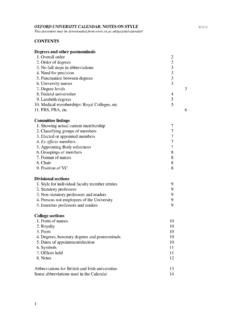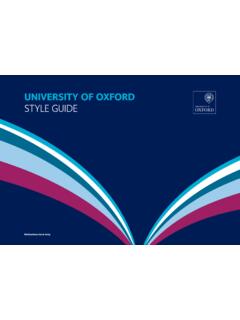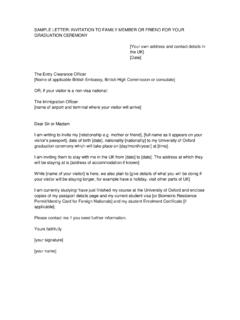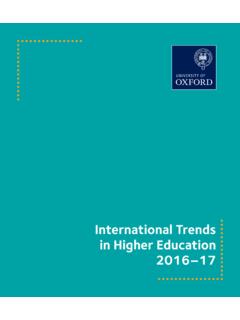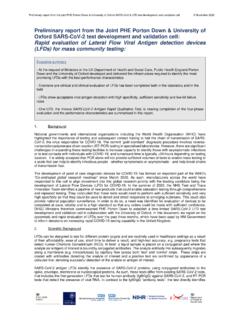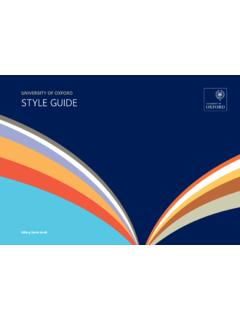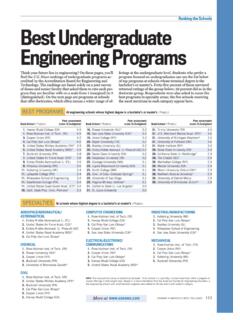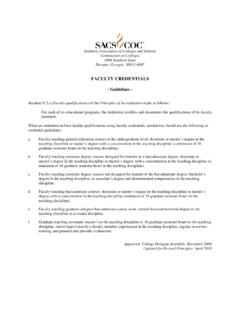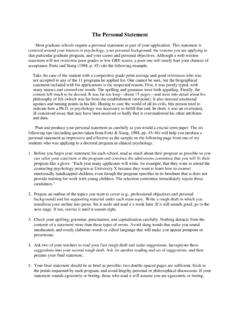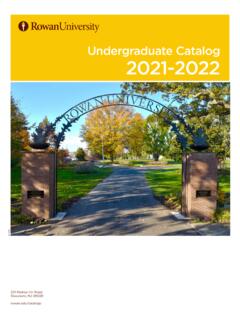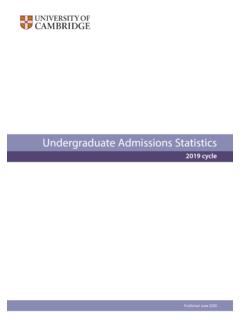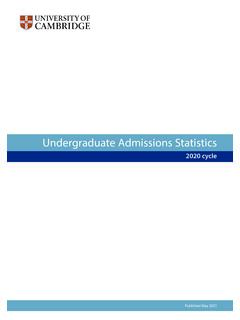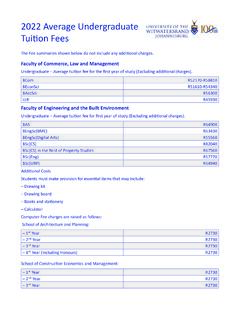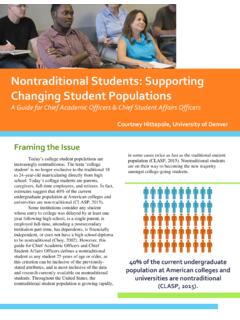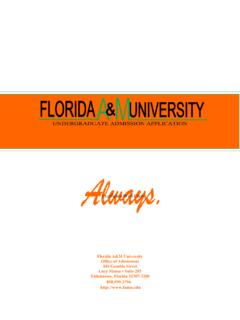Transcription of ANNUAL ADMISSIONS STATISTICAL REPORT
1 ANNUAL ADMISSIONS STATISTICAL REPORTMay 20212021 | UNIVERSITY OF OXFORD ANNUAL ADMISSIONS STATISTICAL REPORTPAG E 2 Foreword For a university with such a strong sense of place, this past year has been a highly unusual one in Oxford, where streets so often teeming with students have largely been silent for long stretches of time. The students who remained, and those studying from home, have displayed exemplary resilience and commitment to their education. Students and staff alike have taken enormous pride in the work of our academics in developing vaccines and therapeutics as well as enhancing our understanding of COVID-19. It is no surprise then that our ADMISSIONS numbers continue to rise as prospective students see the many contributions Oxford makes to society both nationally and the pandemic has, in many ways, changed the way we operate, it has not weakened our commitment to diversifying the make-up of our student body.
2 In this, our fourth ANNUAL ADMISSIONS REPORT , we provide details of the success rate of British undergraduate applications by educational, regional, racial and socio-economic background as well as by subject and college. The highlights are as follows: over the past five years the proportion of students from state schools rose from 58% to The proportion identifying as Black and Minority Ethnic rose from to The proportion from socio-economically disadvantaged areas rose from to The proportion from areas of low progression to higher education rose from to The proportion declaring a disability rose from to The proportion of women rose from to This reflects real progress and is a testament to the dedication of our ADMISSIONS Teams, the support of school teachers and, of course.
3 The many talents of able and ambitious young welcomed our first cohort of students under the new Opportunity Oxford Programme in the autumn and responded rapidly to the pandemic by putting our access and outreach activity online, creating Virtual Open Days and developing digital versions of our signature programmes like UNIQ. In December this year we conducted our ADMISSIONS interviews remotely for the first all the adjustments and adaptations required by the pandemic we remain committed to ensuring that every talented, academically driven pupil in the country, wherever they come from, sees Oxford as a place for Louise RichardsonVice-ChancellorContents page 4 Section 1. Overall numbers, including domicile page 7 Section 2.
4 Nation and regionpage 10 Section 3. Disadvantagepage 16 Section 4. school typepage 19 Section 5. Genderpage 22 Section 6. Ethnicitypage 34 Section 7. Disabilitypage 35 Glossarypage 38 Guide to the Oxford ADMISSIONS processpage 39 Note on HESA dataUNIVERSITY OF OXFORD ANNUAL ADMISSIONS STATISTICAL REPORT | 2021 PAG E 3 About this REPORT This REPORT presents undergraduate ADMISSIONS statistics for the University of Oxford over five ADMISSIONS years between 2016 and 2020, broken down into chapters covering the following areas: overall numbers, domicile, nation and region, disadvantage, school type, gender, ethnicity and disability. The REPORT includes information for Oxford s colleges and largest courses, aggregated for the three ADMISSIONS years 2018 to 2020.
5 Aggregation has been used as small yearly figures are likely to provide a misleading picture. Nonetheless, some figures remain so small that a handful of decisions can appear to create large swings which have limited STATISTICAL value. This health warning applies even more strongly to single-year statistics for colleges and courses. The full data are available to view online: REPORT also provides some national context for Oxford s data, primarily based on figures from the Higher Education Statistics Agency (HESA). This includes information on the numbers of students achieving Oxford s minimum standard offer: three A grades or better at A-level and equivalent Scottish qualifications. It also compares Oxford s data with the higher education sector as a whole and with the Russell Group of leading universities.
6 A summary of Oxford s ADMISSIONS process can be found on page points Following extended school closures in 2020 because of the COVID-19 pandemic, A-levels and other qualifications around the world were awarded using a range of methods including centre-assessed grades in place of the usual examinations. 3,695 students were admitted to Oxford, around 400 more than usual. Almost four fifths of those places (2,950) went to students living in the UK. Between 2016 and 2020, within the total group of UK-domiciled undergraduates admitted: The proportion from state schools rose from to The proportion identifying as Black and Minority Ethnic (BME) rose from to The proportion from socio-economically disadvantaged areas rose from to The proportion from areas of low progression to higher education rose from to The proportion declaring a disability rose from to The proportion of women rose from to Percentages in this REPORT have been rounded to one decimal Some figures are slightly different from those presented in previous editions of this REPORT following data | UNIVERSITY OF OXFORD ANNUAL ADMISSIONS STATISTICAL REPORTPAG E 41.
7 Overall numbers, including domicile This section presents information on Oxford s overall numbers, as well as the domicile of Oxford s applicants, offer holders and admitted NUMBERS The number of students admitted in 2020 was higher than usual following the exceptional arrangements for awarding A-levels and other qualifications during the COVID-19 pandemic. Overall application numbers have risen annually, and by since 2016. Table : Overall applications to Oxford, offers made and students admitted, all domiciles, 2016 2020 APPLICATIONSOFFERSSTUDENTS ADMITTED2020 23,414 3,932 3,695 2019 23,026 3,895 3,286 2018 21,516 3,841 3,310 2017 19,953 3,786 3,285 2016 19,164 3,771 3,282 Table : Courses with the highest number of applicants per place (all domiciles, three-year total 2018 2020)3 COURSENUMBER OF APPLICANTS PER PLACECOURSENUMBER OF APPLICANTS PER PLACEE conomics & * & & Computer ** *Philosophy, Politics and Economics **Including Law/Law with Studies in Europe Note.
8 This table contains aggregated figures for the period 2018 2020. Aggregated figures for this period will appear throughout the REPORT , most often where tables refer to data by course or by grade profile of UK-domiciled students applying to, receiving offers from and being admitted to Oxford (2020 UK intake)s While three A grades is Oxford s minimum standard offer for candidates taking A-levels, many courses particularly in the sciences require at least one A* grade. More than 70% of applicants and over 90% of admitted students were awarded A*AA or better at A-level. of admitted students achieved three A* grades or better at *A AA*A*AA*A*A* O R B E T T E bands are based on results data obtained from UCAS and include results from the 2020 and 2019 examination rounds.
9 Excludes General Studies and Critical Thinking, and candidates with fewer than three A-level 3. Table based on 25 largest OF OXFORD ANNUAL ADMISSIONS STATISTICAL REPORT | 2021 PAG E 5 BREAKDOWN BY DOMICILE Applications from UK students and non-EU students have risen, and applications from EU students have fallen. UK-domiciled applicants are substantially more likely to receive an offer of a place to study at Oxford than students from outside the UK. The proportion of students admitted who are from the UK has risen to Oxford does not operate quotas or targets around the nationality or domicile of students admitted to the University. The exception is Medicine, which is subject to a government restriction on the number of students with international fee status who can be admitted each year.
10 The highest number of overseas applications and admitted students was from the People s Republic of ChinaTable : Overall applications to Oxford, offers made and students admitted by area of domicile, 2016 2020UK STUDENTSAPPLICATIONSOFFERSSTUDENTS ADMITTEDPROPORTION OF TOTAL APPLICANTSPROPORTION OF TOTAL STUDENTS ADMITTED2020 14,102 3,059 2,950 13,881 3,059 2,590 13,013 2,960 2,570 12,596 2,941 2,560 12,209 3,005 2,646 STUDENTSAPPLICATIONSOFFERSSTUDENTS ADMITTEDPROPORTION OF TOTAL APPLICANTSPROPORTION OF TOTAL STUDENTS ADMITTED2020 2,746 292 266 2,773 266 234 2,687 307 273 2,431 302 273 2,417 263 234 STUDENTSAPPLICATIONSOFFERSSTUDENTS ADMITTEDPROPORTION OF TOTAL APPLICANTSPROPORTION OF TOTAL STUDENTS ADMITTED2020 6,566 581 479 6,372 570 462 5,816 574 467 4.

